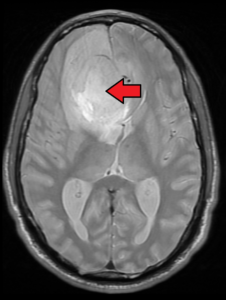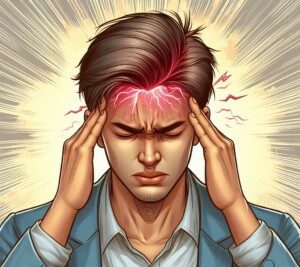Pain in the head or a sudden bad headache or even a medium one that won’t go away is one of the most frightening symptoms.
That’s because the head contains the brain!
And anything involving the brain is not to be taken lightly.
But you should also know that not all headaches have their origins in the brain or head.
Some do originate from a so-called pinched nerve in the neck, or muscle tension in the neck area.
But others do mean that a serious problem is going on with the brain.
Headaches: Leading Reason People See Doctors
“Headaches are quite common and usually do not mean anything serious,” says Morton Tavel, MD, Clinical Professor Emeritus of Medicine, Indiana University School of Medicine, and author of “Health Tips, Myths, and Tricks: A PHYSICIAN’S ADVICE.”
“They can be dull and throbbing, sharp and pinpointed, and can last for a few minutes or a few days,” continues Dr. Tavel.
“By far, the most common type headache is brought about by emotional tension, and these are called tension headaches.”
These originate in the neck and shoulder muscles, and sometimes the muscles of the head. The brain is not involved in these types of headaches.
“They can happen to anyone, at any time, any place,” says Dr. Tavel. “There is good news about headaches in general: They are very common and usually have a benign cause.
“A typical headache may last for only a few hours. Or even several minutes.”
Migraines: Trouble Coming, but Still Benign
The pain can be a level 10 on a 1 to 10 scale, but these are benign in that they aren’t life threatening.
“Migraine headaches are less common and usually follow a characteristic pattern,” says Dr. Tavel.
And that pattern often consists of a pulsing or throbbing pain, rather than steady. It’s often on one side of the head as well.
There may be a nauseous feeling with the pain that can lead to upchucking.
The patient may have considerable sensitivity to light and/or sound.
The pain may go on for days and incapacitate the sufferer.
In addition, the sufferer may have an “aura” or warning signal just before the onset of a migraine.
The warning sign may be in the form of a sudden blind spot in one’s vision, flashing lights or one-sided facial tingling.
Dr. Tavel points out that some medications may be helpful, but also that the sufferer should see a doctor about different migraine treatment options.
“The right medicines, combined with self-help remedies and lifestyle changes, may help.”
When Headaches Mean Serious Trouble

Freepik.com/jcomp
“But what if you are experiencing headaches that won’t go away and do not respond to typical treatment?” says Dr. Tavel.
Another consideration is the presence of concurrent symptoms like loss of appetite, slurred speech, being off balance or one-sided weakness.
Concurrent symptoms, depending on their nature, can signal that a headache’s cause is serious.
“A sudden headache of severe pain that occurs after a head trauma may be a symptom of a more serious medical condition,” says Dr. Tavel.
Namely, this would indicate bleeding in the brain: a subdural hematoma or a subarachnoid hemorrhage.
“Any time a head injury results in a headache [even mild], consult a physician as soon as you can.”
Seek Medical Attention ASAP for the Following Signs

Freepik.com
Stiff neck and fever. A harmless tension headache may come with neck discomfort.
These types come on gradually rather than with a bang.
So if the pain level is ultimately a 7, it didn’t start out as a 7.
The tension type typically begins subtlely, sometimes at a 0.5, then progressing to a 1, then 2, and gradually rising in pain level score.
Or, it can start as a 2. And it’s gradual from that point on as it gets worse.
The discomfort can be bad enough to keep a person in bed.
However…“a sudden, severe headache with a very stiff neck and a fever and/or sensitivity to light may mean a serious situation that requires prompt medical attention,” warns Dr. Tavel.
This could mean a migraine but it could also signal a rupturing brain aneurysm.
The hallmark descriptor for a rupturing brain aneurysm is SUDDEN AND SEVERE — like a clap of thunder.
Numbness or weakness. “Either of these symptoms with a headache, especially with another like problems walking, could indicate a serious condition; see a doctor right away,” says Dr. Tavel.

Brain tumor. Credit: James Heilman, MD
These symptoms could be caused by a brain tumor, either malignant or benign. A stroke could also cause these symptoms with head pain.
Other accompanying signs that are suspicious for a serious cause behind a headache are partial loss of or blurred vision, confusion, and very obviously, convulsions, seizures or loss of consciousness.
A headache that’s accompanied by any level of confusion, let alone loss of consciousness or seizures, likely means a serious disease or serious result of an injury.
The three most likely causes would be:
• Brain tumor
• Brain bleed
• Blood clot (ischemic stroke)
There are other origins of headaches not mentioned here, but one last origin deserves some attention: sinus.
The sinus headache can hurt as much as a tearing aneurysm.
Usually an infection is the cause, and compared to a brain tumor or aneurysm, this sounds pretty benign. But an infection needs to be promptly eradicated.
A much more serious sinus-related cause for a headache, however, is a tumor (cancerous or benign) in the nasal or surrounding cavities. These usually cause additional symptoms and are very rare.

Dr. Tavel’s medical research includes over 125 publications, editorials and book reviews in peer-reviewed national medical journals. He was formerly director of the cardiac rehabilitation program at St. Vincent Hospital in Indiana. mortontavel.com
 Lorra Garrick has been covering medical, fitness and cybersecurity topics for many years, having written thousands of articles for print magazines and websites, including as a ghostwriter. She’s also a former ACE-certified personal trainer.
Lorra Garrick has been covering medical, fitness and cybersecurity topics for many years, having written thousands of articles for print magazines and websites, including as a ghostwriter. She’s also a former ACE-certified personal trainer.
.



























